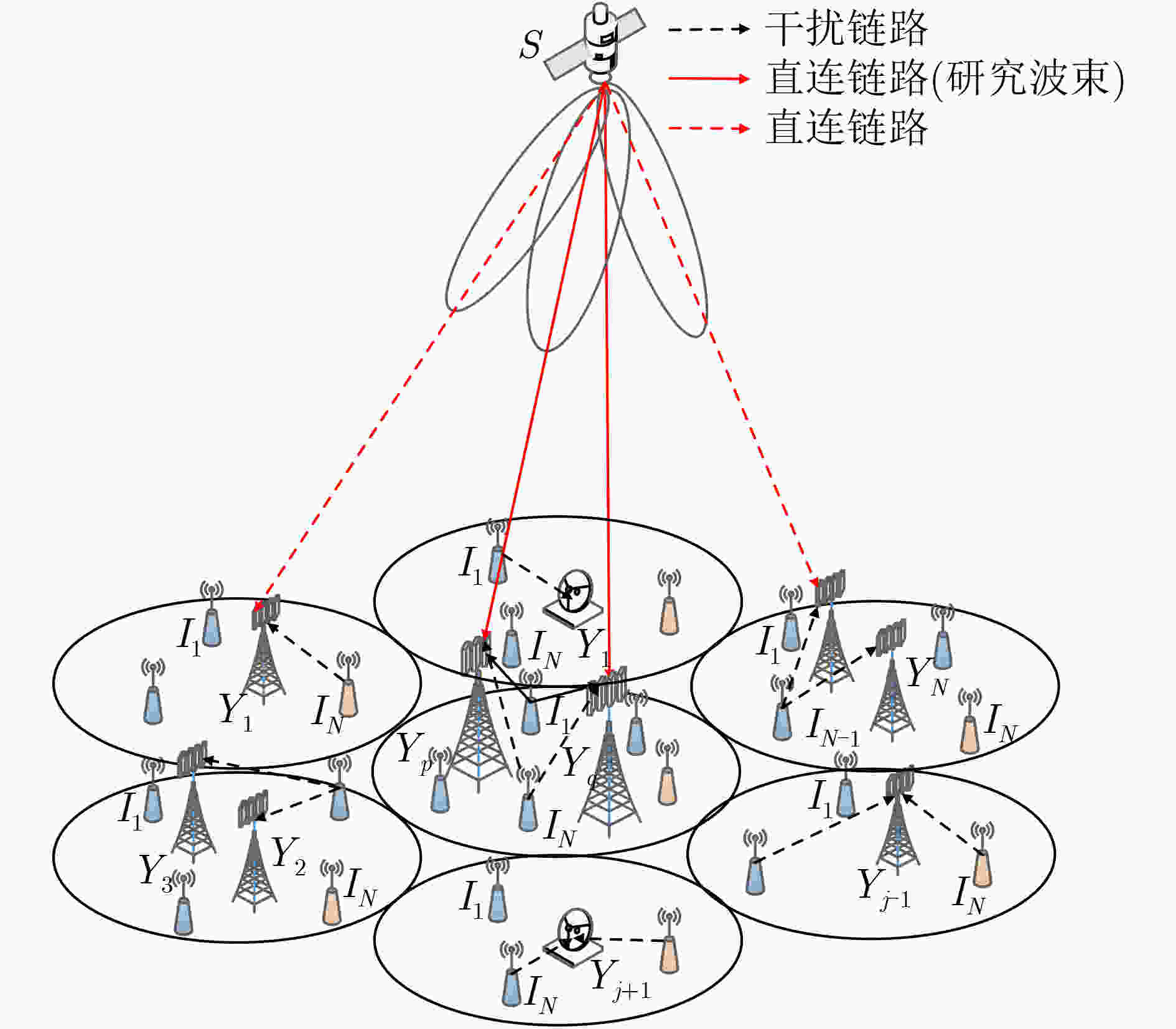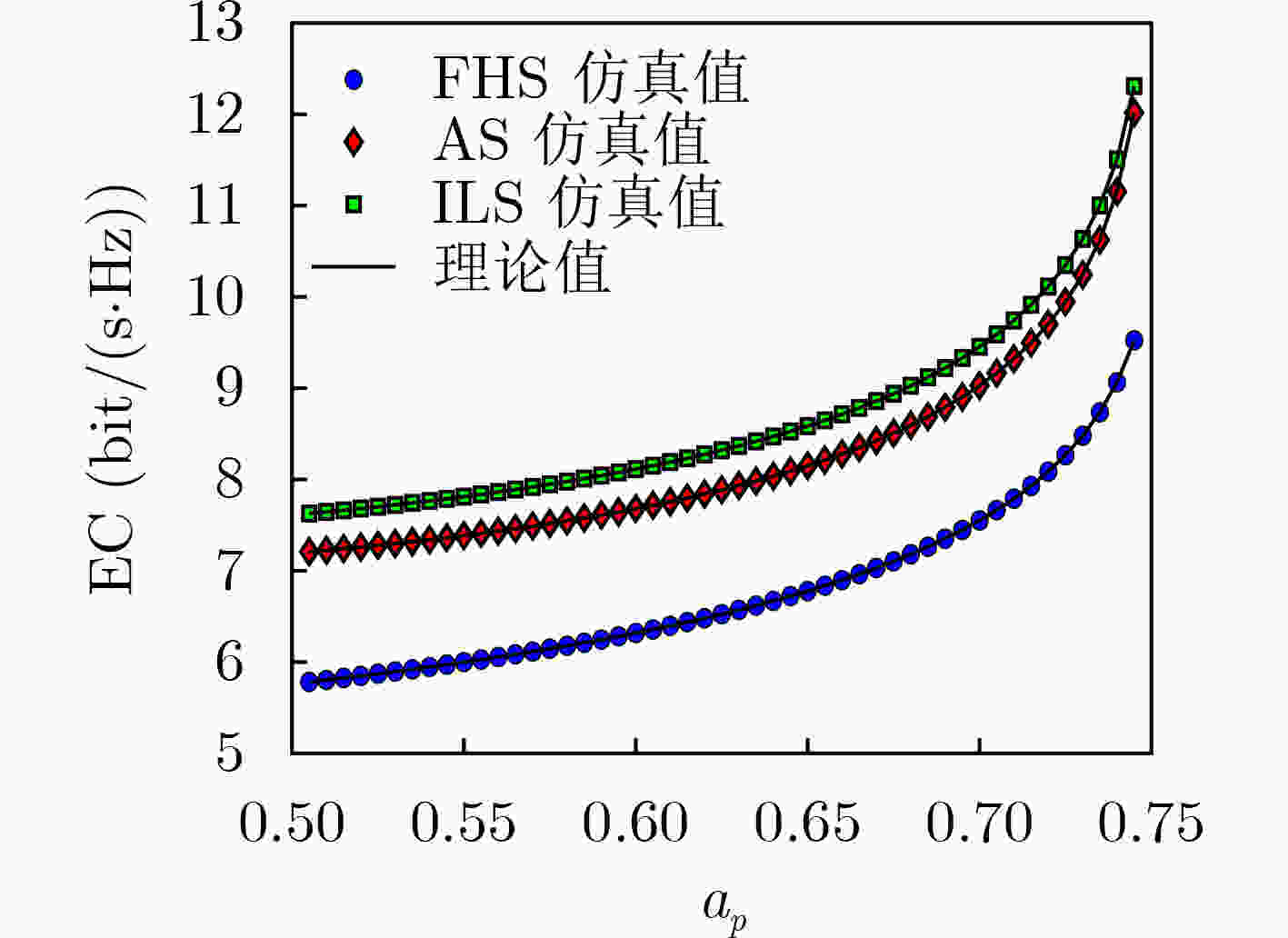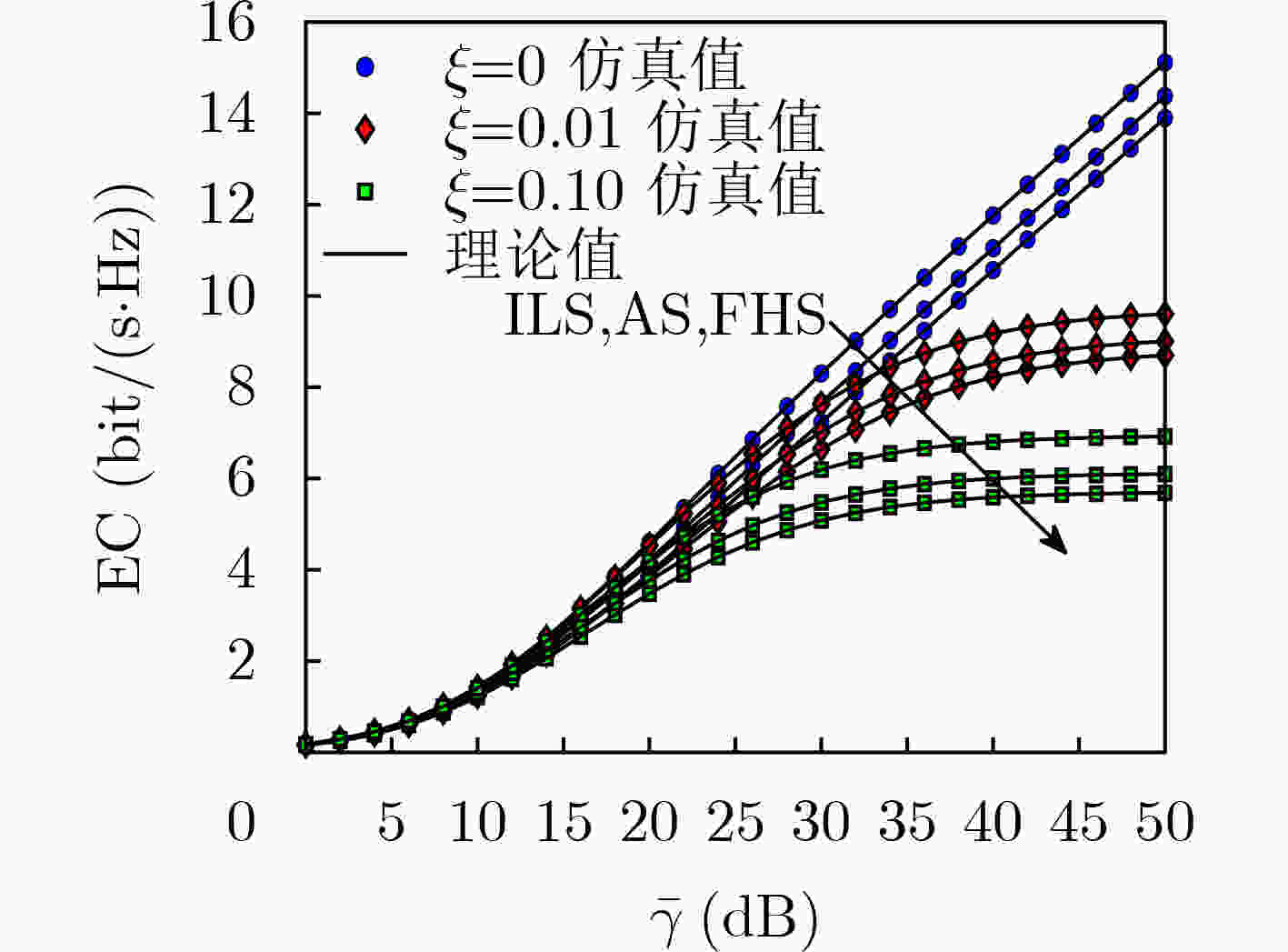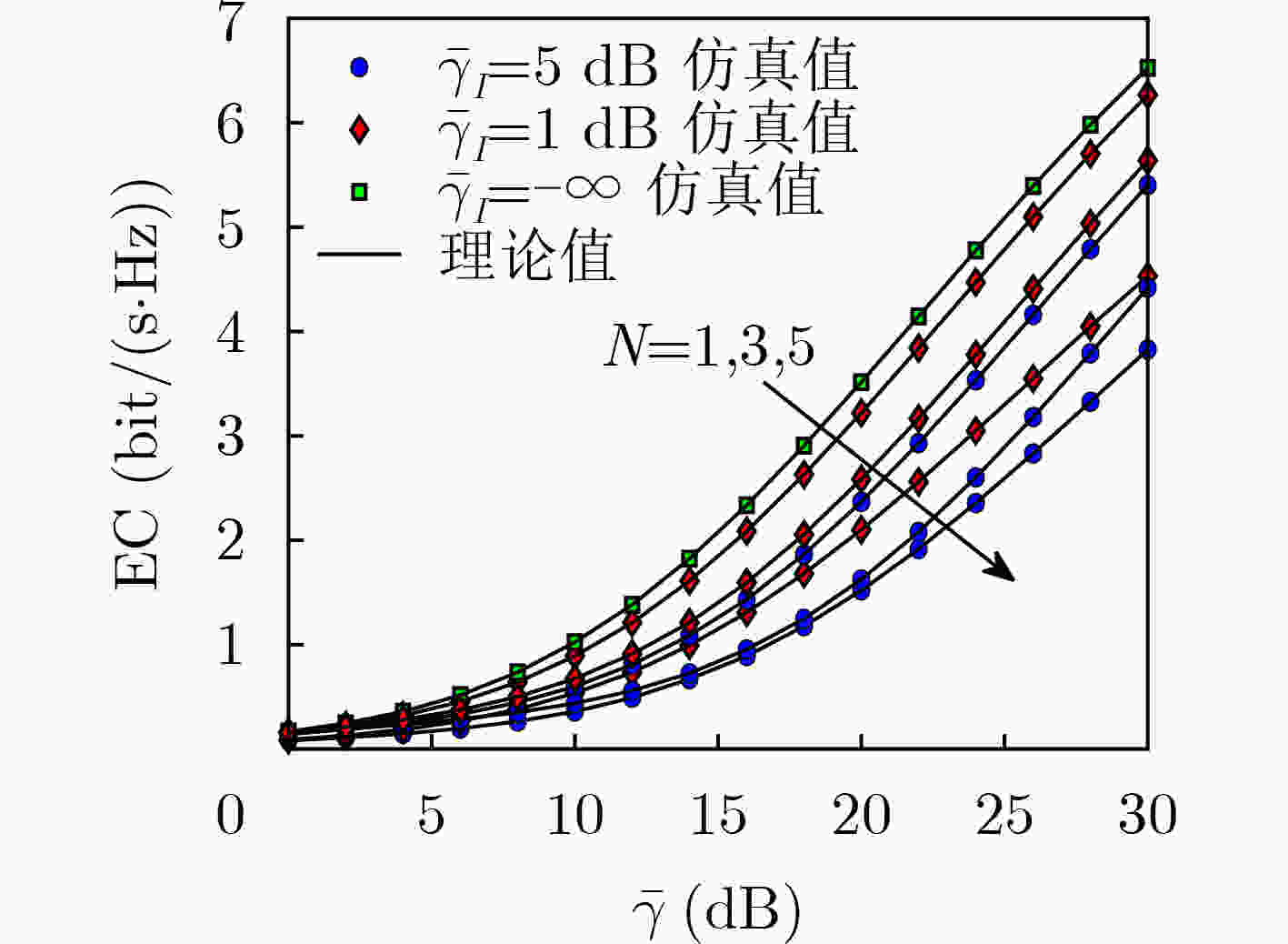On the Performance of Non-Orthogonal Multiple Access Integrated Satellite-Terrestrial Networks in Imperfect Constraints
-
摘要: 随着星地融合网络(ISTNs)的快速发展,大量的传感器和无线设备都有无线服务的接入需求,从而对星地融合网络的频谱效率和服务质量提出了新的挑战。不同于传统的正交多址接入技术,非正交多址接入(NOMA)技术可在相同的频率下传输不同用户的信号,其被认作为提高星地融合网络频谱效率的有效方法,从而被广泛研究。目前,针对NOMA和星地融合网络的研究大多都是在理想条件下进行的,由此该文研究更加实际的情况,即在非完美串行干扰消除(SIC)、信道估计误差和同频干扰下,对星地融合网络的性能进行研究。该文在假设卫星端和地面端均采用多天线的前提下,推导了系统遍历容量的闭式表达式,验证了非完美条件对于系统性能的影响。同时蒙特卡罗仿真验证了理论分析和推导的正确性。Abstract: With the rapid development of Integrated Satellite-Terrestrial Networks (ISTNs), large scale sensors and wireless devices have the demand to access the wireless services, which is a new challenge to the spectrum efficiency and quality of service of ISTNs. Different from the conventional orthogonal multiple access technology, Non-Orthogonal Multiple Access (NOMA) can provide communication guarantee for multiple users in the same frequency. It is considered to be an effective technical path to improve the spectral efficiency of ISTNs, hence it has been widely studied. At present, most of the research on NOMA and ISTNs are investigated under perfect condition. Motivated by this condition, the performance of ISTNs with the more practical situation, i.e., imperfect Successive Interference Cancellation (SIC), channel estimation error and co-channel interference, is studied in this paper. Considering that both satellite and terrestrial users use multiple antennas, the closed-form expression of ergodic capacity is derived, which verifies the impact of imperfect conditions on the system performance. Meanwhile, Monte Carlo simulation is performed to verify the correctness of theoretical derivation results.
-
表 1 系统参数
参数 数值 卫星轨道 GEO 载波频率 18 GHz 载波带宽 50 MHz 3 dB角度 0.4° 最大波束增益 48 dB 接收天线增益 4 dB 噪声温度 300 K 雨衰 $\mu = - 3.125 $, $\delta _\zeta ^2 = 1.591$ 表 2 信道参数
衰落程度 ${m_j}$ ${b_j}$ ${\varOmega _j}$ 重度衰落(Frequent Heavy Shadowing, FHS) 1 0.063 0.0007 中度衰落(Average Shadowing, AS) 5 0.251 0.2790 轻度衰落(Infrequent Light Shadowing, ILS) 10 0.150 1.2900 -
[1] GUO Kefeng, AN Kang, ZHANG Bangning, et al. Physical layer security for multiuser satellite communication systems with threshold-based scheduling scheme[J]. IEEE Transactions on Vehicular Technology, 2020, 69(5): 5129–5141. doi: 10.1109/TVT.2020.2979496 [2] LIN Min, HUANG Qingquan, DE COLA T, et al. Integrated 5G-satellite networks: a perspective on physical layer reliability and security[J]. IEEE Wireless Communications, 2020, 27(6): 152–159. doi: 10.1109/MWC.001.2000143 [3] 胡晗, 鲍楠, 凌章, 等. 基于NOMA的移动边缘计算系统公平能效调度算法[J]. 电子与信息学报, 2021, 43(12): 3563–3570. doi: 10.11999/JEIT200898HU Han, BAO Nan, LING Zhang, et al. Fair energy efficiency scheduling in NOMA-based mobile edge computing[J]. Journal of Electronics &Information Technology, 2021, 43(12): 3563–3570. doi: 10.11999/JEIT200898 [4] 吴广富, 邓天垠, 苏开荣, 等. 基于非正交多址接入系统的多用户分组优化算法[J]. 电子与信息学报, 2018, 40(9): 2080–2087. doi: 10.11999/JEIT171220WU Guangfu, DENG Tianyin, SU Kairong, et al. Multi-user grouping optimization algorithm based on non-orthogonal multiple access systems[J]. Journal of Electronics &Information Technology, 2018, 40(9): 2080–2087. doi: 10.11999/JEIT171220 [5] SINGH V, UPADHYAY P K, and LIN Min. On the performance of NOMA-assisted overlay multiuser cognitive satellite-terrestrial networks[J]. IEEE Wireless Communications Letters, 2020, 9(5): 638–642. doi: 10.1109/LWC.2020.2963981 [6] LIN Zhi, LIN Min, WANG Junbo, et al. Joint beamforming and power allocation for satellite-terrestrial integrated networks with non-orthogonal multiple access[J]. IEEE Journal of Selected Topics in Signal Processing, 2019, 13(3): 657–670. doi: 10.1109/JSTSP.2019.2899731 [7] ZHANG Xiaokai, ZHANG Bangning, AN Kang, et al. On the performance of hybrid satellite-terrestrial content delivery networks with non-orthogonal multiple access[J]. IEEE Wireless Communications Letters, 2021, 10(3): 454–458. doi: 10.1109/LWC.2020.3029621 [8] LIN Zhi, LIN Min, CHAMPAGNE B, et al. Secrecy-energy efficient hybrid beamforming for satellite-terrestrial integrated networks[J]. IEEE Transactions on Communications, 2021, 69(9): 6345–6360. doi: 10.1109/TCOMM.2021.3088898 [9] AN Kang, LIN Min, LIANG Tao, et al. Performance analysis of multi-antenna hybrid satellite-terrestrial relay networks in the presence of interference[J]. IEEE Transactions on Communications, 2015, 63(11): 4390–4404. doi: 10.1109/TCOMM.2015.2474865 [10] GUO Kefeng, LIN Min, ZHANG Bangning, et al. Performance analysis of hybrid satellite-terrestrial cooperative networks with relay selection[J]. IEEE Transactions on Vehicular Technology, 2020, 69(8): 9053–9067. doi: 10.1109/TVT.2020.2999752 [11] FAMORIJI O J and XU Zhiwei. Antenna feed array synthesis for efficient communication systems[J]. IEEE Sensors Journal, 2020, 20(24): 15085–15098. doi: 10.1109/JSEN.2020.3012444 [12] GUO Kefeng, AN Kang, ZHANG Bangning, et al. On the performance of cognitive satellite-terrestrial relay networks with channel estimation error and hardware impairments[J]. Sensors, 2018, 18(10): 3292. doi: 10.3390/s18103292 [13] SOLANKI S, UPADHYAY P K, DA COSTA D B, et al. Joint impact of RF hardware impairments and channel estimation errors in spectrum sharing multiple-relay networks[J]. IEEE Transactions on Communications, 2018, 66(9): 3809–3824. doi: 10.1109/TCOMM.2018.2832623 [14] HUANG Qingquan, LIN Min, ZHU Weiping, et al. Uplink massive access in mixed RF/FSO satellite-aerial-terrestrial networks[J]. IEEE Transactions on Communications, 2021, 69(4): 2413–2426. doi: 10.1109/TCOMM.2021.3049364 [15] RUAN Yuhan, JIANG Lijuan, LI Yongzhao, et al. Energy-efficient power control for cognitive satellite-terrestrial networks with outdated CSI[J]. IEEE Systems Journal, 2021, 15(1): 1329–1332. doi: 10.1109/JSYST.2020.2975025 [16] 王夕予, 许晓明, 陈亚军. 非理想连续干扰消除下非正交多址接入上行传输系统性能分析[J]. 电子与信息学报, 2019, 41(12): 2795–2801. doi: 10.11999/JEIT181165WANG Xiyu, XU Xiaoming, and CHEN Yajun. Performances analysis in uplink non-orthogonal multiple access system with imperfect successive interference cancellation[J]. Journal of Electronics &Information Technology, 2019, 41(12): 2795–2801. doi: 10.11999/JEIT181165 [17] LI Xingwang, LIU Meng, DENG Chao, et al. Full-duplex cooperative NOMA relaying systems with I/Q imbalance and imperfect SIC[J]. IEEE Wireless Communications Letters, 2020, 9(1): 17–20. doi: 10.1109/LWC.2019.2939309 [18] YUE Xinwei, LIU Yuanwei, YAO Yuanyuan, et al. Outage behaviors of NOMA-based satellite network over shadowed-Rician fading channels[J]. IEEE Transactions on Vehicular Technology, 2020, 69(6): 6818–6821. doi: 10.1109/TVT.2020.2988026 [19] RUAN Yuhan, LI Yongzhao, WANG Chengxiang, et al. Energy efficient power allocation for delay constrained cognitive satellite terrestrial networks under interference constraints[J]. IEEE Transactions on Wireless Communications, 2019, 18(10): 4957–4969. doi: 10.1109/TWC.2019.2931321 [20] GUO Kefeng, AN Kang, ZHANG Bangning, et al. On the performance of the uplink satellite multiterrestrial relay networks with hardware impairments and interference[J]. IEEE Systems Journal, 2019, 13(3): 2297–2308. doi: 10.1109/JSYST.2019.2901800 [21] GRADSHTEYN I S and RYZHIK I M. Table of Integrals, Series, and Products[M]. 7th ed. Amsterdam: Elsevier, 2007. [22] KÖLBIG K S. Reviewed Work: Integrals and series of special functions. by A. P. Prudnikov, Yu. A. Bryčkov, O. I. Maričev[J]. Mathematics of Computation, 1985, 44(170): 573–574. doi: 10.2307/2007975 -






 下载:
下载:






 下载:
下载:
